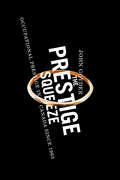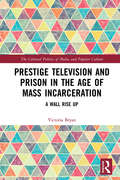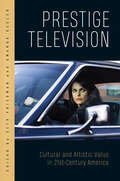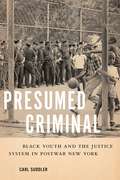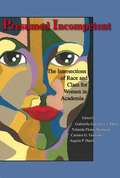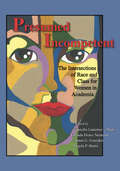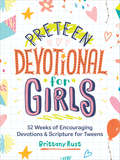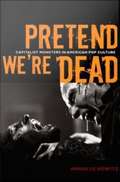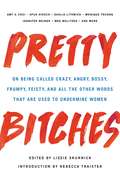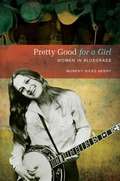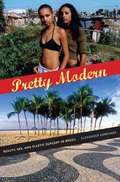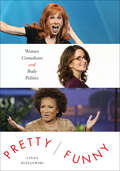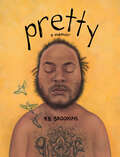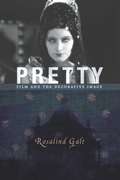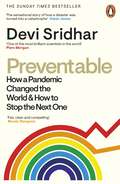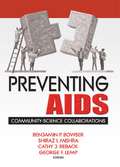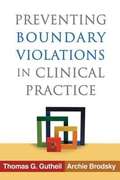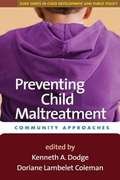- Table View
- List View
Prestige Squeeze
by John GoyderSociologists have studied occupational prestige for decades, including a landmark national survey in 1965 by Peter Pineo and John Porter. John Goyder updates Pineo and Porter's work, providing a detailed comparison of their results with a similar national scale survey conducted in 2005. The results challenge the accepted view that prestige ratings are constant over time and across societies. Goyder shows that there have been some surprising changes in these ratings: instead of the expected premium on jobs in the knowledge sector, more traditional occupations - such as the skilled trades, even if they require little education or pay a low wage - have gained the most prestige. There has been a significant decrease in consensus about occupational prestige ratings and the tendency for respondents to upgrade the prestige of their own occupation is much more pronounced in the recent data. Goyder argues that these changes are a sign of the shifting nature of values in a meritocratic society in which increasing income inequality is a growing reality.
Prestige Squeeze: Occupational Prestige in Canada since 1965
by John GoyderSociologists have studied occupational prestige for decades, including a landmark national survey in 1965 by Peter Pineo and John Porter. John Goyder updates Pineo and Porter's work, providing a detailed comparison of their results with a similar national scale survey conducted in 2005. The results challenge the accepted view that prestige ratings are constant over time and across societies. Goyder shows that there have been some surprising changes in these ratings: instead of the expected premium on jobs in the knowledge sector, more traditional occupations - such as the skilled trades, even if they require little education or pay a low wage - have gained the most prestige. There has been a significant decrease in consensus about occupational prestige ratings and the tendency for respondents to upgrade the prestige of their own occupation is much more pronounced in the recent data. Goyder argues that these changes are a sign of the shifting nature of values in a meritocratic society in which increasing income inequality is a growing reality.
Prestige Television and Prison in the Age of Mass Incarceration: A Wall Rise Up (The Cultural Politics of Media and Popular Culture)
by Victoria M. BryanTelevision shows that we might call ‘prestige television’ represent prison in ways that are sometimes reductive, sometimes powerful, and sometimes exceedingly complex. This book examines various programmes across the genres of drama, comedy and horror that utilize prison or places of incarceration as a central theme or setting to show how they conform to or challenge the standard conversation about the prison industrial complex and the common understanding of prisons as violent spaces where we house the worst among us. Drawing on the work of Angela Davis, Doran Larson, Dylan Rodriguez, Michelle Alexander, and Lisa Guenther, the author presents focused studies of Orange Is the New Black, Rectify, American Horror Story and The Walking Dead (along with briefer discussions of The 100, police procedurals, and popular sitcoms) to explore the responsibility of television to represent prison in as authentic a fashion as possible, the exploitation of the incarcerated in reductive representations of prison, and the shifting nature of the national conversation about prison as it is depicted on screen. As such, the book will appeal to scholars of cultural and media studies, criminology and sociology with interests in incarceration and representations of prison in popular culture.
Prestige Television: Cultural and Artistic Value in Twenty-First-Century America
by Murray Leeder Javier Ramirez Seth Friedman Catherine Martin David R. Coon Amanda Keeler Justin O. Rawlins Andrew J. Bottomley Wyatt D. Phillips Josie Torres BarthPrestige Television explores how a growing array of 21st century US programming is produced and received in ways that elevate select series above the competition in a saturated market. Contributing authors demonstrate that these shows are positioned and understood as comprising an increasingly recognizable genre characterized by familiar markers of distinction. In contrast to most accounts of elite categorizations of contemporary US television programming that center on HBO and its primary streaming rivals, these essays examine how efforts to imbue series with prestigious or elevated status now permeate the rest of the medium, including network as well as basic and undervalued premium cable channels. Case study chapters focusing on diverse series, ranging from widely recognized examples such as The Americans (2013-2018) and The Knick (2014-15) to contested examples like Queen of the South (2016-2021) and How I Met Your Mother (2005-2014), highlight how contributing authors extend conceptions of the genre beyond expected parameters.
Presumed Criminal: Black Youth and the Justice System in Postwar New York
by Carl SuddlerA startling examination of the deliberate criminalization of black youths from the 1930s to todayA stark disparity exists between black and white youth experiences in the justice system today. Black youths are perceived to be older and less innocent than their white peers. When it comes to incarceration, race trumps class, and even as black youths articulate their own experiences with carceral authorities, many Americans remain surprised by the inequalities they continue to endure. In this revealing book, Carl Suddler brings to light a much longer history of the policies and strategies that tethered the lives of black youths to the justice system indefinitely.The criminalization of black youth is inseparable from its racialized origins. In the mid-twentieth century, the United States justice system began to focus on punishment, rather than rehabilitation. By the time the federal government began to address the issue of juvenile delinquency, the juvenile justice system shifted its priorities from saving delinquent youth to purely controlling crime, and black teens bore the brunt of the transition.In New York City, increased state surveillance of predominantly black communities compounded arrest rates during the post–World War II period, providing justification for tough-on-crime policies. Questionable police practices, like stop-and-frisk, combined with media sensationalism, cemented the belief that black youth were the primary cause for concern. Even before the War on Crime, the stakes were clear: race would continue to be the crucial determinant in American notions of crime and delinquency, and black youths condemned with a stigma of criminality would continue to confront the overwhelming power of the state.
Presumed Guilty: When Innocent People Are Wrongly Convicted
by Martin Yant"In the following chapters, you will see how and why such outrageous miscarriages of justice occur and what can be done to avoid them. You will also see how most of these egregious errors are the result of mere chance and could happen to anyone-including you. Find that hard to believe? Then wait till you see how engineer Lenell Geter ended up with a life sentence for armed robbery because he read books and fed the ducks in a park during his lunch hour. Wait till you see how Randall Dale Adams came within three days of being executed for the murder of a police officer he had nothing to do with because he ran out of gas at the wrong place and the wrong time. Wait till you see how William Jackson Marion was executed for the murder of a man found to be alive four years later. Wait till you see how a desperately poor couple who abandoned their seriously ill daughter in hopes she would receive the care they couldn't afford were convicted of her murder, only to have her discovered alive and well twenty months later. Wait till you see how Joyce Ann Brown ended up in prison for almost ten years because the car used in a robbery-murder was rented by another Joyce Ann Brown. Wait till you see how innocent people are convicted or sentenced to death largely because of the testimony of inexpert "expert witnesses" for hire, faulty forensics tests, and inaccurate polygraph exams. Wait till you see what it cost the Reverend Bernard Pagano before another man confessed to the crimes with which the Roman Catholic priest was charged. Wait till you see the cross that Bible-college student Steven Linscott has had to bear because he believed a nightmare he had might have been a spiritual sign that could help police solve a murder. Wait till you see how Larry Hicks was almost executed for a murder he didn't commit because he helped some neighbors move and had a lazy court-appointed attorney who didn't even bother to appeal his conviction."
Presumed Incompetent
by Yolanda Flores Niemann Angela P. Harris Gabriella Gutiérrez y Muhs Carmen G. GonzálezPresumed Incompetent is a pathbreaking account of the intersecting roles of race, gender, and class in the working lives of women faculty of color. Through personal narratives and qualitative empirical studies, more than 40 authors expose the daunting challenges faced by academic women of color as they navigate the often hostile terrain of higher education, including hiring, promotion, tenure, and relations with students, colleagues, and administrators. The narratives are filled with wit, wisdom, and concrete recommendations, and provide a window into the struggles of professional women in a racially stratified but increasingly multicultural America.
Presumed Incompetent II: Race, Class, Power, and Resistance of Women in Academia
by Yolanda Flores Niemann Gabriella Gutiérrez y Muhs Carmen G. GonzálezThe courageous and inspiring personal narratives and empirical studies in Presumed Incompetent II: Race, Class, Power, and Resistance of Women in Academia name formidable obstacles and systemic biases that all women faculty—from diverse intersectional and transnational identities and from tenure track, terminal contract, and administrative positions—encounter in their higher education careers. They provide practical, specific, and insightful guidance to fight back, prevail, and thrive in challenging work environments. This new volume comes at a crucial historical moment as the United States grapples with a resurgence of white supremacy and misogyny at the forefront of our social and political dialogues that continue to permeate the academic world. Contributors: Marcia Allen Owens, Sarah Amira de la Garza, Sahar Aziz, Jacquelyn Bridgeman, Jamiella Brooks, Lolita Buckner Inniss, Kim Case, Donna Castaneda, Julia Chang, Meredith Clark, Meera Deo, Penelope Espinoza, Yvette Flores, Lynn Fujiwara, Jennifer Gomez, Angela Harris, Dorothy Hines, Rachelle Joplin, Jessica Lavariega Monforti, Cynthia Lee, Yessenia Manzo, Melissa Michelson, Susie E. Nam, Yolanda Flores Niemann, Jodi O’Brien, Amelia Ortega, Laura Padilla, Grace Park, Stacey Patton, Desdamona Rios, Melissa Michal Slocum, Nellie Tran, Rachel Tudor, Pamela Tywman Hoff, Adrien Wing, Jemimah Li Young
Presumed Incompetent: The Intersections of Race and Class for Women in Academia
by Yolanda Flores Niemann Angela P. Harris Gabriella Gutiérrez y Muhs Carmen G. GonzálezPresumed Incompetent is a pathbreaking account of the intersecting roles of race, gender, and class in the working lives of women faculty of color. Through personal narratives and qualitative empirical studies, more than 40 authors expose the daunting challenges faced by academic women of color as they navigate the often hostile terrain of higher education, including hiring, promotion, tenure, and relations with students, colleagues, and administrators. The narratives are filled with wit, wisdom, and concrete recommendations, and provide a window into the struggles of professional women in a racially stratified but increasingly multicultural America.
Preteen Devotional for Girls: 52 Weeks of Encouraging Devotions and Scriptures for Tweens
by Brittany Rust52 weeks of uplifting devotions and prayers for girls ages 10−12The preteen years can be complicated, and this conversational devotional helps girls find their voice and inner strength through God&’s love and light. Brittany Rust, an experienced Bible teacher with a passion for helpin teens know God and His Word, discusses and interprets Scripture in a way that makes it easy for kids to understand and speaks to everyday preteen concerns, like friends and cliques, self-esteem, privacy, social media, and crushes.Preteen Devotional for Girls features: • 52 weekly devotions organized by themes like &“Relationships,&” &“Faith,&” and &“Feelings and Identity&” provide discussions of Scripture and how God&’s word can help find solutions and security • Friendly, encouraging tone strikes the perfect balance of wise, supportive mentorship and relatability • Open-ended prompts are thought-provoking and encourage preteens to trust God and themselves • A path to regular practice of Bible study and prayer is carved out through one devotion per week, easing tweens into a natural interest and desire for study and reflection • The full-color pages and fun design create an interactive experience and boost creativity and self-expression
Pretend We're Dead: Capitalist Monsters in American Pop Culture
by Annalee NewitzIn Pretend We're Dead, Annalee Newitz argues that the slimy zombies and gore-soaked murderers who have stormed through American film and literature over the past century embody the violent contradictions of capitalism. Ravaged by overwork, alienated by corporate conformity, and mutilated by the unfettered lust for profit, fictional monsters act out the problems with an economic system that seems designed to eat people whole. Newitz looks at representations of serial killers, mad doctors, the undead, cyborgs, and unfortunates mutated by their involvement with the mass media industry. Whether considering the serial killer who turns murder into a kind of labor by mass producing dead bodies, or the hack writers and bloodthirsty actresses trapped inside Hollywood's profit-mad storytelling machine, she reveals that each creature has its own tale to tell about how a freewheeling market economy turns human beings into monstrosities. Newitz tracks the monsters spawned by capitalism through b movies, Hollywood blockbusters, pulp fiction, and American literary classics, looking at their manifestations in works such as Norman Mailer's "true life novel" The Executioner's Song; the short stories of Isaac Asimov and H. P. Lovecraft; the cyberpunk novels of William Gibson and Marge Piercy; true-crime books about the serial killers Ted Bundy and Jeffrey Dahmer; and movies including Modern Times (1936), Donovan's Brain (1953), Night of the Living Dead (1968), RoboCop (1987), The Silence of the Lambs (1991), and Artificial Intelligence: AI (2001). Newitz shows that as literature and film tell it, the story of American capitalism since the late nineteenth century is a tale of body-mangling, soul-crushing horror.
Pretended: Historical, Cultural and Personal Perspectives
by Catherine LeePretended is a vivid historical, political and cultural account of schools and teaching under Section 28, a law that banned schools in the UK from promoting homosexuality as a 'pretended family relationship'.Catherine Lee was a teacher in schools for each of the 15 years that Section 28 was law (between 1988 and 2003). In Pretended, she considers the landscape for lesbian and gay teachers leading up to, during and after Section 28. Drawing on her diary entries from the Section 28 era, Lee poignantly recalls the challenges and incidents affecting her and thousands of other teachers during this period of state-sanctioned homophobia. She reveals how these diaries led to her involvement in the 2022 feature film Blue Jean, and describes how this unexpected opportunity helped her to make peace with Section 28.Pretended will resonate with every lesbian and gay teacher who experienced Section 28 and will shock those who previously knew nothing about this law. Crucially, Pretended will explain to those who were lesbian and gay students during Section 28 why they never saw people like them in the curriculum, never had a role model and never had an adult in school to talk to about their identity.
Pretended: Historical, Cultural and Personal Perspectives
by Catherine LeePretended is a vivid historical, political and cultural account of schools and teaching under Section 28, a law that banned schools in the UK from promoting homosexuality as a 'pretended family relationship'.Catherine Lee was a teacher in schools for each of the 15 years that Section 28 was law (between 1988 and 2003). In Pretended, she considers the landscape for lesbian and gay teachers leading up to, during and after Section 28. Drawing on her diary entries from the Section 28 era, Lee poignantly recalls the challenges and incidents affecting her and thousands of other teachers during this period of state-sanctioned homophobia. She reveals how these diaries led to her involvement in the 2022 feature film Blue Jean, and describes how this unexpected opportunity helped her to make peace with Section 28.Pretended will resonate with every lesbian and gay teacher who experienced Section 28 and will shock those who previously knew nothing about this law. Crucially, Pretended will explain to those who were lesbian and gay students during Section 28 why they never saw people like them in the curriculum, never had a role model and never had an adult in school to talk to about their identity.
Pretty Bitches: On Being Called Crazy, Angry, Bossy, Frumpy, Feisty, and All the Other Words That Are Used to Undermine Women
by Lizzie SkurnickThese empowering essays from leading women writers examine the power of the gendered language that is used to diminish women -- and imagine a more liberated world.Words matter. They wound, they inflate, they define, they demean. They have nuance and power. "Effortless," "Sassy," "Ambitious," "Aggressive": What subtle digs and sneaky implications are conveyed when women are described with words like these? Words are made into weapons, warnings, praise, and blame, bearing an outsized influence on women's lives -- to say nothing of our moods.No one knows this better than Lizzie Skurnick, writer of the New York Times' column "That Should be A Word" and a veritable queen of cultural coinage. And in Pretty Bitches, Skurnick has rounded up a group of powerhouse women writers to take on the hidden meanings of these words, and how they can limit our worlds -- or liberate them. From Laura Lipmann and Meg Wolizer to Jennifer Weiner and Rebecca Traister, each writer uses her word as a vehicle for memoir, cultural commentary, critique, or all three. Spanning the street, the bedroom, the voting booth, and the workplace, these simple words have huge stories behind them -- stories it's time to examine, re-imagine, and change.
Pretty Good for a Girl: Women in Bluegrass (Music in American Life)
by Murphy Hicks HenryThe first book devoted entirely to women in bluegrass, Pretty Good for a Girl documents the lives of more than seventy women whose vibrant contributions to the development of bluegrass have been, for the most part, overlooked. Accessibly written and organized by decade, the book begins with Sally Ann Forrester, who played accordion and sang with Bill Monroe's Blue Grass Boys from 1943 to 1946, and continues into the present with artists such as Alison Krauss, Rhonda Vincent, and the Dixie Chicks. Drawing from extensive interviews, well-known banjoist Murphy Hicks Henry gives voice to women performers and innovators throughout bluegrass's history, including such pioneers as Bessie Lee Mauldin, Wilma Lee Cooper, and Roni and Donna Stoneman; family bands including the Lewises, Whites, and McLains; and later pathbreaking performers such as the Buffalo Gals and other all-girl bands, Laurie Lewis, Lynn Morris, Missy Raines, and many others.
Pretty Modern: Beauty, Sex, and Plastic Surgery in Brazil
by Alexander EdmondsPretty Modern is a riveting account of Brazil's emergence as a global leader in plastic surgery. Intrigued by a Carnaval parade that mysteriously paid homage to a Rio de Janeiro plastic surgeon, anthropologist Alexander Edmonds conducted research that took him from Ipanema socialite circles to glitzy telenovela studios to the packed waiting rooms of public hospitals offering free cosmetic surgery. The result is provocative exploration of the erotic, commercial, and intimate aspects of beauty in a nation with extremes of wealth and poverty and a reputation for natural sensuality. Drawing on conversations with maids and their elite mistresses, divorced housewives, black celebrities, and favela residents aspiring to be fashion models, Edmonds analyzes what sexual desirability means and does for women in different social positions. He argues that beauty is a distinct realm of modern experience that does not simply reflect other inequalities. It mimics the ambiguous emancipatory potential of capital, challenging traditional hierarchies while luring consumers into a sexual culture that reduces the body to the brute biological criteria of attractiveness. Illustrated with color photographs, Pretty Modern offers a fresh theoretical perspective on the significance of female beauty in consumer capitalism.
Pretty Powerful: Appearance, Substance, and Success
by Eboni K. WilliamsFOX News co-host and radio personality Eboni K. Williams believes that women shouldn’t hide their beauty. Instead, they should embrace it as a positive and powerful asset. Williams describes how her own career has been positively influenced by making strategic and intentional decisions about her appearance, what works best and when, all while staying true to her own personal style and values. Regardless of the decade, whether they were entering the workforce, seeking a leadership role, or looking to ascend to the C-suite, women (and even men) have always felt the professional need to embody a certain aesthetic appeal and individual personal power. Women, especially, have been sold the lie that being “pretty” comes at the expense of being taken seriously and that being “pretty” and being capable are mutually exclusive. In PRETTY POWERFUL, Eboni K. Williams encourages readers to reject the knee-jerk reaction to be shamed by this potential advantage and to stop leaving this incredibly powerful asset unused. In each chapter, Williams is joined by other powerful women like Meghan McCain, Marcia Clark, and Desiree Rogers and explores how many others have learned to balance their “prettiness” with substance—to both look the part and express their intelligence in a way that is authentic and respected. While opinions may have differed through time, one fact remains: a personal “pretty” brand is perhaps the most immediate and obvious tool in a woman’s professional arsenal.
Pretty/Funny: Women Comedians and Body Politics
by Linda Mizejewski“A totally engaging read [and] a fascinating look at the diversity and range of female comics . . . by an author who herself obviously has a sense of humor.” —Joanna E. Rapf, coeditor of The Blackwell Companion to Film ComedyWomen in comedy have traditionally been pegged as either “pretty” or “funny.” Attractive actresses with good comic timing such as Katherine Hepburn, Lucille Ball, and Julia Roberts have always gotten plum roles as the heroines of romantic comedies and television sitcoms. But fewer women who write and perform their own comedy have become stars—and often they’ve been successful because they were willing to be funny-looking, from Fanny Brice and Phyllis Diller to Lily Tomlin and Carol Burnett.Pretty/Funny focuses on Kathy Griffin, Tina Fey, Sarah Silverman, Margaret Cho, Wanda Sykes, and Ellen DeGeneres, the groundbreaking women comics who flout the pretty-versus-funny dynamic by targeting glamour, postfeminist girliness, the Hollywood A-list, and feminine whiteness with their wit and biting satire. Linda Mizejewski demonstrates that while these comics don’t all identify as feminists or take politically correct positions, their work on gender, sexuality, and race has a political impact. The first major study of women and humor in twenty years, Pretty/Funny makes a convincing case that women’s comedy has become a prime site for feminism to speak, talk back, and be contested in the twenty-first century.
Pretty/Funny: Women Comedians and Body Politics
by Linda Mizejewski“A totally engaging read [and] a fascinating look at the diversity and range of female comics . . . by an author who herself obviously has a sense of humor.” —Joanna E. Rapf, coeditor of The Blackwell Companion to Film ComedyWomen in comedy have traditionally been pegged as either “pretty” or “funny.” Attractive actresses with good comic timing such as Katherine Hepburn, Lucille Ball, and Julia Roberts have always gotten plum roles as the heroines of romantic comedies and television sitcoms. But fewer women who write and perform their own comedy have become stars—and often they’ve been successful because they were willing to be funny-looking, from Fanny Brice and Phyllis Diller to Lily Tomlin and Carol Burnett.Pretty/Funny focuses on Kathy Griffin, Tina Fey, Sarah Silverman, Margaret Cho, Wanda Sykes, and Ellen DeGeneres, the groundbreaking women comics who flout the pretty-versus-funny dynamic by targeting glamour, postfeminist girliness, the Hollywood A-list, and feminine whiteness with their wit and biting satire. Linda Mizejewski demonstrates that while these comics don’t all identify as feminists or take politically correct positions, their work on gender, sexuality, and race has a political impact. The first major study of women and humor in twenty years, Pretty/Funny makes a convincing case that women’s comedy has become a prime site for feminism to speak, talk back, and be contested in the twenty-first century.
Pretty: A Memoir
by KB BrookinsBy a prize-winning, young Black trans writer of outsized talent, a fierce and disciplined memoir about queerness, masculinity, and race.Even as it shines light on the beauty and toxicity of Black masculinity from a transgender perspective—the tropes, the presumptions—Pretty is as much a powerful and tender love letter as it is a call for change. &“I should be able to define myself, but I am not. Not by any governmental or cultural body,&” Brookins writes. &“Every day, I negotiate the space between who I am, how I&’m perceived, and what I need to unlearn. People have assumed things about me, and I can&’t change that. Every day, I am assumed to be a Black American man, though my ID says &‘female,&’ and my heart says neither of the sort. What does it mean—to be a girl-turned-man when you&’re something else entirely?&” Informed by KB Brookins&’s personal experiences growing up in Texas, those of other Black transgender masculine people, Black queer studies, and cultural criticism, Pretty is concerned with the marginalization suffered by a unique American constituency—whose condition is a world apart from that of cisgender, non-Black, and non-masculine people. Here is a memoir (a bildungsroman of sorts) about coming to terms with instantly and always being perceived as &“other&”
Pretty: Film and the Decorative Image (Film and Culture Series)
by Rosalind GaltFilm culture often rejects visually rich images, treating simplicity, austerity, or even ugliness as the more provocative, political, and truly cinematic choice. Cinema may challenge traditional ideas of art, but its opposition to the decorative represents a long-standing Western aesthetic bias against feminine cosmetics, Oriental effeminacy, and primitive ornament. Inheriting this patriarchal, colonial perspective-which treats decorative style as foreign or sexually perverse-filmmakers, critics, and theorists have often denigrated colorful, picturesque, and richly patterned visions in cinema.Condemning the exclusion of the "pretty" from masculine film culture, Rosalind Galt reevaluates received ideas about the decorative impulse from early film criticism to classical and postclassical film theory. The pretty embodies lush visuality, dense mise-en-scène, painterly framing, and arabesque camera movements-styles increasingly central to world cinema. From European art cinema to the films of Wong Kar-wai and Santosh Sivan, from the experimental films of Derek Jarman to the popular pleasures of Moulin Rouge!, the pretty is a vital element of contemporary cinema, communicating distinct sexual and political identities. Inverting the logic of anti-pretty thought, Galt firmly establishes the decorative image as a queer aesthetic, uniquely able to figure cinema's perverse pleasures and cross-cultural encounters. Creating her own critical tapestry from perspectives in art theory, film theory, and philosophy, Galt reclaims prettiness as a radically transgressive style, shimmering with threads of political agency.
Preventable: How a Pandemic Changed the World & How to Stop the Next One
by Devi Sridhar**THE SUNDAY TIMES BESTSELLER | BBC RADIO 4 BOOK OF THE WEEK**The definitive story of COVID-19 and how global politics shape our health - from a world-leading expert and the pandemic's go-to science communicator Professor Devi Sridhar has risen to prominence for her vital roles in communicating science to the public and speaking truth to power. In Preventable she highlights lessons learned from outbreaks past and present in a narrative that traces the COVID-19 pandemic - including her personal experience as a scientist - and sets out a vision for how we can better protect ourselves from the inevitable health crises to come.In gripping and heartfelt prose, Sridhar exposes the varied realities of those affected and puts you in the room with key decision makers at crucial moments. She vibrantly conveys the twists and turns of a plot that saw: deadlier varients emerge (contrary to the predictions of social media pundits who argued it would mutate to a milder form); countries with weak health systems like Senegal and Vietnam fare better than countries like the US and UK (which were consistently ranked as the most prepared); and the quickest development of game-changing vaccines in history (and their unfair distribution)Combining science, politics, ethics and economics, this definitive book dissects the global structures that determine our fate, and reveals the deep-seated economic and social inequalities at their heart - it will challenge, outrage and inspire.'A brutally compelling reminder that if voices like Devi's had been listened to, so many more could have lived' OWEN JONES'One of the most brilliant scientists in the world who has been proven consistently right in this crisis' PIERS MORGAN'Excellent . . . Fair, clear and compelling' NICOLA STURGEON'Those who have found Professor Devi Sridhar's expertise and calm advice invaluable since the arrival of Covid-19 will be glad to know that she has written Preventable' RACHEL COOKE, Guardian, Non-fiction to look out for in 2022
Preventing AIDS: Community-Science Collaborations
by R Dennis Shelby Benjamin Bowser Shiraz Mishra Cathy RebackLearn how to create professional collaboration between HIV/AIDS researchers and community organizations for the benefit of all! This book is designed to help frontline prevention organizations answer two questions that are of utmost importance. First, how effective are their services; and second, can their work be improved? The absence of rigorous evaluation is a barrier to stable funding for community organizations, and the strategies in Preventing AIDS: Community-Science Collaborations can help overcome that barrier. The book is a guide to successful cooperative efforts between researchers and community-based organizations. The information it presents will help community-based programs acquire detailed, timely information on program effectiveness and outcomes. It also provides researchers with methods for accessing hard-to-reach or hidden HIV high-risk groups. Handy tables and figures make important data easy to access and understand. In Preventing AIDS: Community-Science Collaborations, you&’ll learn about the difficult but critically important collaboration between community organizations who do frontline prevention work and university scientists who evaluate the effectiveness of that work. The book describes the community-researcher equal partner collaboration (CREPC) model for community-based collaborative research. In addition, it examines six unique efforts to prevent the spread of AIDS among high-risk populations, such as prostitutes, injection drug users, impoverished pregnant women, migrant workers, transgendered persons, and prison inmates. The case studies in Preventing AIDS: Community-Science Collaborations describe the frustrations of outreach workers and counselors who suddenly must help design a survey they fear will be intrusive, and the parallel problems faced by scientists who are told that their traditional measures mean little to outreach workers. Preventing AIDS: Community-Science Collaborations presents funders&’ perspectives on collaborative AIDS research and examines the collaborative and funding aspects of: the CAL-PEP prevention programs for drug injectors and sex workers efforts to promote HIV prevention for migrant farm workers and evaluate those efforts&’ effectiveness the ongoing collaboration between The Center for AIDS Prevention Studies (University of California, San Francisco), Centerforce (a statewide nonprofit agency providing services and advocacy to prisoners and their families), and San Quentin State Prison the effort of the Los Angeles County HIV Epidemiology Program and three community-based organizations, which collaborate to provide culturally appropriate outreach and HIV education/prevention services to transgendered individuals of various ethnic origins San Francisco&’s PHREDA project and the way its creators collaborated to better understand and serve high-risk women The U-Find-Out (UFO) Study, funded by the Universitywide AIDS Research Program of the State of California
Preventing Boundary Violations in Clinical Practice
by Thomas G. Gutheil Archie BrodskyWhat do you do when you run into a patient in a public place? How do you respond when a patient suddenly hugs you at the end of a session? Do you accept a gift that a patient brings to make up for causing you some inconvenience? Questions like these which virtually all clinicians face at one time or another have serious clinical, ethical, and legal implications. This authoritative, practical book uses compelling case vignettes to show how a wide range of boundary questions arise and can be responsibly resolved as part of the process of therapy. Coverage includes role reversal, gifts, self-disclosure, out-of-office encounters, physical contact, and sexual misconduct. Strategies for preventing boundary violations and managing associated legal risks are highlighted.
Preventing Child Maltreatment
by Doriane Coleman Kenneth DodgeMany child abuse prevention programs have targeted factors within the family, such as parenting skills. This book describes the next wave of prevention the promotion of safer, healthier childrearing environments in entire communities. The contributors are leading authorities who illuminate how contextual factors including poverty, chaotic neighborhoods, and lack of social supports combine with family factors to place children at risk for maltreatment. They present a range of exemplary programs designed to strengthen communities while also helping individual parents to meet their children's needs. Real-world evaluation approaches, quality-control strategies, and policy implications are discussed in depth.
